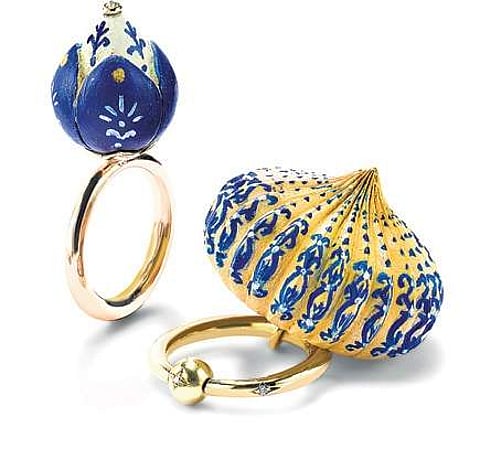

It is easier to take an inspiration and churn out aesthetically similar pieces of jewellery, year after year. The real deal is when someone takes a cue from an age-old painting, a design movement or a dome glistening in the sun, makes it their own, and spins a nouvelle narrative out of it. Alice Cicolini’s jewellery is all about this.
She candidly attributes her initiation into the world of jewellery to India, where she once stood enamoured by a bejeweled box meant for solah-shringar, exhibited at the museum of Jodhpur’s Mehrangarh Fort. “What stayed with me was how the ritual is part tactile and part sensory.
I found it powerfully evocative,” the former director of arts and culture at British Council in India says. She started her eponymous label with a thought of marrying the two in 2009. Cicolini later created the Jodhpur collection as a tribute to the spot where it all began, the museum that brought her closer to her passion.
What began as an inspiration took shape of a bond that has only grown stronger. Today, Rajasthan is a big part of her life as a jeweller. She works closely with a team of skilled enamel (known in Europe as champlevé) artists under the tutelage of Kamal Kumar Meenakar (from the famous meenakar family of Jaipur that has practiced the craft for over two hundred years) to create pieces that are iridescent and yet hard-wearing, thanks to the use of 22-carat gold.
The jewellery pieces are adorned with ornate enamel work, done in Jaipur. Detailing is innate to her designs. This is why you will find meenakari even at the back, an additional gold sphere or hand-carved stones. Getting the jewellery handcrafted in India and London, Cicolini does not shy away from colours, using hand-carved, hand-polished and hand-faceted semi-precious stones in every possible colours—opal, sapphire, peridot, tourmaline, garnet, ruby, topaz, quartz, amethyst, freshwater pearls and diamonds—including black.
It is for her love for stones that Cicolini does not mind creating bespoke pieces with anyone walking up to her with a stone to design around it. “There are two ways of doing it. One is made-to-measure method, where I can recreate a piece from my collection by using new stones or colours. Or I work with a fresh concept, a stone, or a client’s inspiration to create something entirely new,” says the alumnus and research associate at London’s Central St Martins. She gets the stone scanned in India, where it can be handcrafted for a price starting at £5,000.
For last seven years, this author of The New English Dandy, has journeyed through the ancient silk route, with pit stops in Afghan, Uzbek, Ottoman, and Oriental cultures, juxtaposing the sources—miniature paintings of Rajasthan, Benarasi silk saris, chhatri, Lord Krishna’s favourite lotus buds, Uzbek domes, kimono patterns—to create rings and hoops and neckpieces with modern silhouette, making it global-audience-ready. She replaces the haute joiallerie approach with a more playful undertone, retailing from Twist, Net A Porter, Dover Street Market, Grange Hall, August, Mouki Mou, Meister, Capitol, Reinhold and her own website (alicecicolini.com) priced at £275-£20,000.
Before she gets busy with designing a new line each for the year-end and global stockiest network, Cicolini tells us about her upcoming collaboration in Paris with Thomas Erber’s Cabinet de Curiosities for one of the cities last remaining palaces. We will have an eye on it.